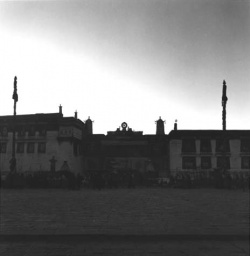The Kora of the Jokhang temple
The Jokhang, Tibetan Buddhism's most sacred temple, stands broad and low in the Heart of old Lhasa, the recipient of Prayers of daily worshippers and once-in-a-lifetime pilgrims. These photographs are part of a project that documents The Kora, the sacred Path of worship that circles the Jokhang.
From earliest dawn to last Light, Tibetans arrive to make the circumambulation of the Jokhang to earn religious Merit. Yet, The Kora is also a residential area and a market, the Heart of Lhasa where Tibetans live, meet, socialize and shop. Houses and stores fill the spaces between the smaller temples, Prayer poles and Prayer Wheels. Broken only by intersecting alleys, the buildings transform The Kora into an enclosed lane. All day long there is Constant movement: a clock-wise flowing stream of worshippers, shoppers and vendors, inhabitants.
The area around the Jokhang, however, is changing rapidly. Traditional Tibetan homes and buildings, among the oldest in Lhasa, are being razed and families being relocated to make Way for new, often characterless and cultureless stores and stalls not owned by Tibetans. With this, Tibetan heritage and a Way of Life are disappearing.
The Kora Photographic Project was a means of documenting and preserving this heritage of Tibet. The images present the religious, cultural and architectural history of Tibet. They also call attention to the need to save this heritage.
The photographs in Kora I were taken early in the morning, just as the sun peaked over the eastern mountains and roof tops. At this Time of day, The Kora is empty save for those walking its Path for Merit, leaving the presence of the buildings to speak for themselves. In the project, I photographed from exactly in front of all the buildings on The Kora (as well as numerous vistas). The images are continuous, so that each window, doorway and alley is documented in precise Order. This was done for each side of the lane for the full one kilometer of The Kora's length using a medium format 2-1/4" camera.
A second version of the project, taken with a 35 mm film, recorded The Kora throughout the course of a day. It is dawn entering The Kora, to the left of the Jokhang's entrance. The day progresses as the images move around the Path of The Kora. In this version, Tibetan worshippers, stall keepers and residents are included in the photographs. Photographs for both versions of the project were completed during the summer of 1994.
Kora II contains other photographs of people and details on The Kora made from 1993-1995.
A show of other color and black & white photographs of Tibet by Amina Tirana, taken from 1993-1995, will be presented by the Newton Library in Boston, from 1-29 March, 1996. The library is at 330 Homer Street, Newton, Massachusetts (617-552-7145).
Kora I
Jokhang Temple, Front of The Kora (early dawn)
The sun rises behind the Jokhang Temple. In the midnight and pre-dawn dark, The Kora is magnificently quiet. As the sky lightens, yet long before the sun casts Light on the temple's front, Tibetans walk The Kora, stopping their circumambulation to Light Incense in one of five kilns or to prostrate at the front of the Jokhang.
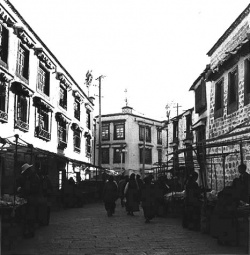 |
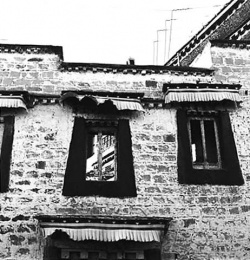 |
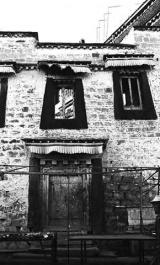
|
| Looking Down the Entrance to The Kora northwest corner of The Kora |
Windows of the Jokhang Temple north side of The Kora |
Windows of the Jokhang Temple north side of The Kora |
left to Right
Looking Down the Entrance to The Kora, northwest corner of The Kora
Taken just steps into the entrance of The Kora, this image looks at the northwestern corner where the main lane turns east and is met by a small adjoining alley from the north. At this corner, vendors sell yogurt, milk and bread each morning.
Windows of the Jokhang Temple, (two photos) north side of The Kora
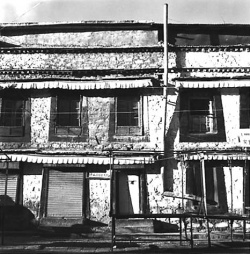 |
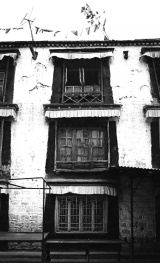 |
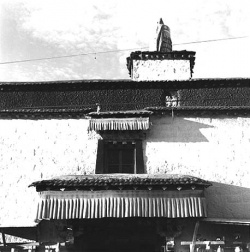 |
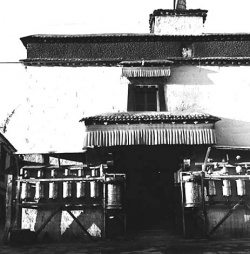
|
left to Right
Homes Above Shops, north side of The Kora
North Kora, north side of The Kora
Like many buildings along The Kora, this one has a Store on the ground floor and homes above. The stone work--large stone mortared by smaller chipped ones--is traditionally Tibetan. Like most Tibetan structures in Lhasa, Prayer flags top this building. Tibetan Buddhists believe that each flutter of a Prayer Flag releases the Prayer printed on it into the cosmos.
The Large Prayer Wheel House, (two photos) north side of The Kora
Halfway down the north side of The Kora, there is a small temple encasing a large Prayer Wheel. A row of small Prayer Wheels is mounted on the square building's outer walls. Many Tibetans turn the large Prayer Wheel thrice, then turn all the smaller wheels on the outside to earn religious Merit.
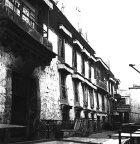 |
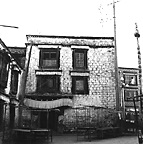 |
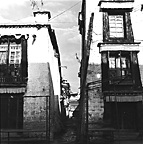
|
left to Right
North Kora, north side of The Kora
This house is one of the older houses in Lhasa. In its main entrance (at far left of the frame), beneath the large window, there is now a Muslim tea shop serving noodle soup and tea.
Vanished Building, northeast corner of The Kora
This building, and several others near it, were razed in mid-1995. A several storied structure is replacing it, set farther back from The Kora.
Alley to the Jokhang, east side of The Kora
Between buildings on the west side of the eastern part of The Kora is a narrow alley that leads back to a temple, and a rear entrance to the Jokhang. At the back of the Jokhang, the alley turns north, emerging beside the large Prayer Wheel. Tibetans always walk The Kora in a clockwise Direction. This alley is sometimes used as a short cut, when Tibetans want to get to the tromsikang market or other place on the north side of The Kora without contradicting the proper religious Directions, but don't want to walk the long Way round to get to a point just behind them.
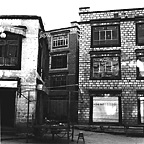 |
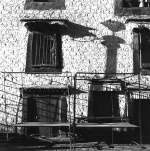 |
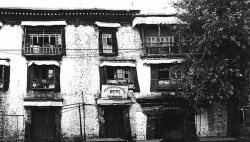
|
left to Right
New Buildings, east side of The Kora
Both the center and Right hand buildings were completed in the summer of 1994, replacing older, lower, smaller buildings. The building on the left, while painted traditional white, is not that old, evidenced by its straight (not inward sloping) walls, and use of cinder block. Fewer and fewer of the new buildings in Lhasa are being painted traditional white, and embellishes and woodwork around the windows diminishing. As well, the seemingly small increase from two or three stories to four stories is transforming the narrow back alleys (and rooms on lower floors) from bright open spaces, to dark, cavernous ones.
South Side of The Kora
The ubiquitous metal stalls echo and frame the square windows of the houses and buildings. The Kora and area around it has become valuable retail property. Stores set out goods on these stalls, and also let them to other vendors. In the evening, Tibetans and Chinese come with bundles of produce, Clothes and other goods, and sell from tarps placed down in the center of The Kora Path itself.
bLa-brang-rning-pa House, south side of The Kora
Once a house of nobility, this building has long been divided into apartments. The dark band of red at the top, dotted with white paint, was, in previous eras, a mark reserved for certain Noble houses.
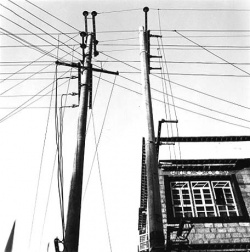 |
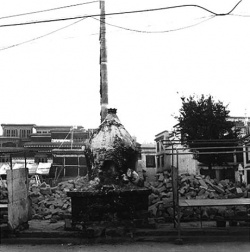 |
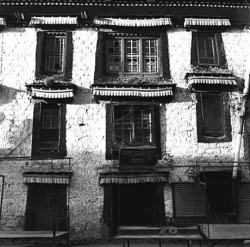
|
left to Right
Marks of Modern Lhasa (electric pole and house corner), south side of The Kora
Incense Kiln and Prayer Pole, south side of The Kora
During the day, vendors sell Clothes, thankas (religious paintings), Prayer flags, sculptures, shoes and all kinds of other goods at the metal stalls surrounding this Incense kiln and all along The Kora. On auspicious days, such as full moons and holidays, many people burn juniper in the kilns, filling the air with white smoke. The south side of the Jokhang is at rear.
Noble's House, south side of The Kora
One side of this massive, old house looks north onto one side of the Jokhang Temple. Like the bLa-brang-rning-pa House nearby, this was also a house of nobles.
Kora II
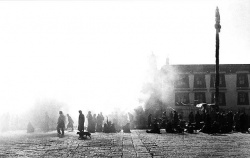
Morning at the Jokhang (Juniper Mist) Lhasa. May, 1993
In the mornings, especially on auspicious days, Tibetans burn juniper and other Incense in front of temples and on roof tops. This morning, the juniper smoke was particularly heavy in front of Tibetan Buddhism's most sacred temple, the Jokhang.
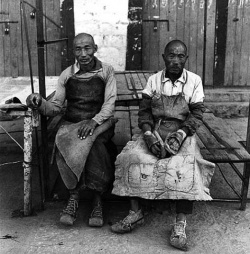
Taking a Rest Lhasa. May, 1993
These two men prostrate the one kilometer Kora (Path of circumambulation) around the Jokhang Temple in Order to earn Spiritual Merit. The wood paddles, heavy leather aprons and tire strips on their shoes protect them from Constant rubbing against the ground.
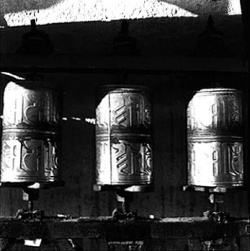
Prayer Wheels Lhasa. May, 1993
On the outer walls of a small temple housing a large Prayer Wheel, on the north side of The Kora around the Jokhang Temple.
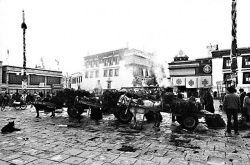
Morning at the Jokhang Lhasa. May, 1993
In the early morning, horses bring carts laden with juniper to the front of the Jokhang Temple. Throughout the day vendors sell the juniper for Incense, which is burned in the kilns by the Jokhang.
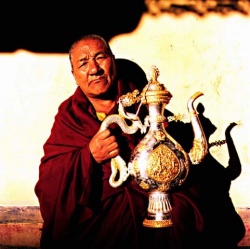
Roof of the Jokhang Temple. November, 1993
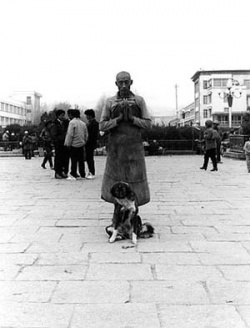
The Prostrator (with dog)Lhasa. November, 1993
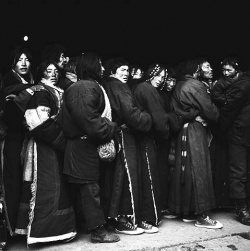
Line Lhasa. November, 1993
These pilgrims from rural Tibet are waiting to enter the inner sanctum of the Jokhang Temple on the holiday of Goddess Palden Lhamo, the only day of the year when the face of Statues of Palden Lhamo are revealed.
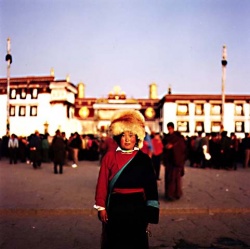
In the Barkor Square. November, 1993
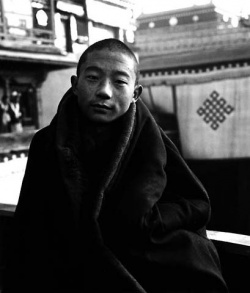
Novice On the roof of the Jokhang Temple. 28 November, 1993
Source
Images and text © 1995, Amina Tirana
For more Information contact Amina Tirana at: 104607.3246@compuserve.com
www.asianart.com

